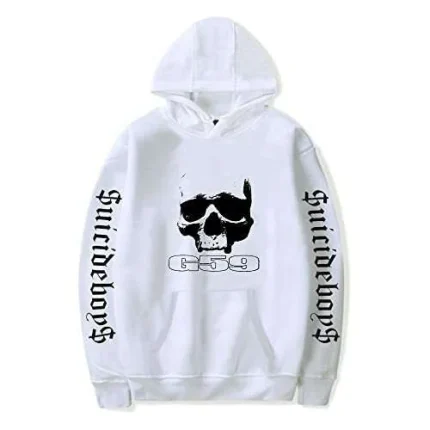Introduction to the Underground Appeal
$uicideboy$, the underground rap duo hailing from New Orleans, has become more than just a music phenomenon; they’ve created a cultural movement. Central to this movement is their merch, which resonates with Gen Z in a way that transcends traditional band apparel. Unlike mainstream merchandise, $uicideboy$ merch embodies a raw authenticity that appeals to young people searching for identity in a hyper-digitalized world.
Merch as a Symbol of Identity
For Gen Z, fashion is a form of self-expression, and $uicideboy$ merch offers a unique avenue for this expression. Wearing a $uicideboy$ hoodie or tee is not just a statement about musical taste—it’s a declaration of individuality. The designs often feature dark, rebellious themes and bold graphics that challenge conventional aesthetics. In a generation that prizes authenticity over conformity, this merch serves as a badge of belonging to a community that values honesty and artistic integrity.
The Intersection of Music and Fashion
$uicideboy$ merch is more than clothing; it’s an extension of the duo’s music and philosophy. The lyrics and visuals in their songs reflect themes of mental health struggles, existential angst, and societal critique. This ethos is mirrored in their merch, allowing fans to carry those narratives into their daily lives. The connection between music and fashion is seamless, creating a lifestyle brand that goes beyond mere merchandising.
Gen Z’s Embrace of Streetwear Culture
Streetwear has become a dominant force in Gen Z fashion, and $uicideboy$ merch fits perfectly within this landscape. Hoodies, oversized tees, and graphic prints are staples of streetwear culture, and $uicideboy$ merch taps into that aesthetic while maintaining a distinct edge. Fans layer their merch with designer sneakers, ripped jeans, and statement accessories, blending underground vibes with mainstream trends. This fusion highlights how Gen Z navigates identity through curated self-presentation, mixing accessibility with exclusivity.
Exclusivity and the Hype Factor
Limited drops and seasonal releases have amplified the desirability of $uicideboy$ merch. Scarcity creates a sense of urgency, turning items into coveted collectibles rather than everyday apparel. Gen Z, a generation accustomed to instant access, finds value in the exclusivity of these pieces. Owning a rare hoodie or shirt becomes a marker of cultural awareness and social capital within fan communities and streetwear circles.
Digital Communities and Merch Culture
Social media platforms like TikTok, Instagram, and Discord have become essential spaces for $uicideboy$ fans to showcase their merch. Outfit posts, unboxing videos, and styling tutorials allow users to engage with the brand and with each other. These digital communities reinforce the cultural significance of the merch by creating spaces for shared experiences, creativity, and validation. The online circulation of merch imagery enhances the perception of $uicideboy$ as a lifestyle rather than just a music act.
Psychological Resonance with Gen Z
The aesthetic of $uicideboy$ merch resonates on a psychological level with many young people. Themes of melancholy, rebellion, and counterculture reflect the inner experiences of Gen Z, who often face intense social pressures and a fast-paced, digitally saturated environment. Wearing the merch can be an act of self-therapy or solidarity, allowing fans to externalize emotions and connect with others who feel similarly. In this way, the merch functions as both fashion and emotional language.
DIY and Customization Trends
Customization is another factor that elevates $uicideboy$ merch in Gen Z culture. Fans frequently modify their clothing through DIY alterations, embroidery, or layering, adding personal flair to the original designs. This participatory approach aligns with Gen Z’s preference for authenticity and self-directed creativity. The ability to reinterpret the merch allows the wearer to assert control over their fashion narrative, transforming a mass-produced item into a unique expression of identity.
The Blend of High Fashion and Underground Style
An interesting trend among Gen Z is pairing $uicideboy$ merch with high-fashion pieces. Oversized band tees under designer coats, hoodies with luxury sneakers, and graphic prints paired with tailored pants showcase a hybrid approach to style. This juxtaposition challenges traditional fashion hierarchies, demonstrating that streetwear and underground aesthetics can coexist with luxury. The blending of these worlds reflects a larger cultural shift where authenticity, suicideboys merch not brand prestige, dictates fashion value.
Merch as a Cultural Touchstone
Beyond individual style, $uicideboy$ merch has become a cultural touchstone. It signifies membership in a broader subculture that values music, art, and shared experiences. Fans use merch to communicate affiliations, tastes, and even philosophies without speaking a word. In this sense, the clothing becomes semiotic, carrying meaning far beyond fabric and ink. The merch operates as a visual shorthand for a lifestyle, one that celebrates countercultural ideals while embracing modern fashion sensibilities.
Sustainability and Ethical Considerations
Interestingly, Gen Z’s approach to $uicideboy$ merch also intersects with sustainability concerns. Many fans repurpose old merch, trade items within fan networks, or buy secondhand. This cyclical approach reduces waste and aligns with broader generational values around environmental responsibility. It demonstrates how subcultural fashion can coexist with ethical consumption, turning merch into both a personal statement and a socially conscious practice.
Influence on Broader Fashion Trends
The aesthetic of $uicideboy$ merch has begun to influence mainstream fashion trends. Graphic-heavy, oversized pieces are increasingly visible in high-street and luxury collections, signaling that what begins in subcultures often permeates wider markets. This influence underscores the role of Gen Z as tastemakers; their adoption of underground merch informs the direction of fashion in ways that extend far beyond music fandom.
Conclusion: Beyond Clothing
$uicideboy$ merch is far more than a product line; it is a cultural phenomenon with deep significance for Gen Z. It bridges music, fashion, identity, and digital culture, offering a mode of self-expression that is authentic, participatory, and socially connected. By wearing the merch, fans participate in a living culture, one that values emotion, creativity, and individuality. In a world where fashion often prioritizes appearance over meaning, $uicideboy$ merch stands as a testament to the power of clothing as a vessel for identity and cultural dialogue.


